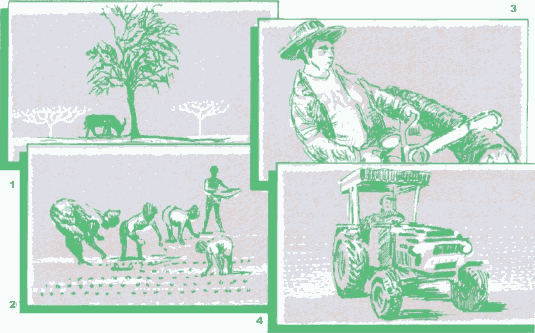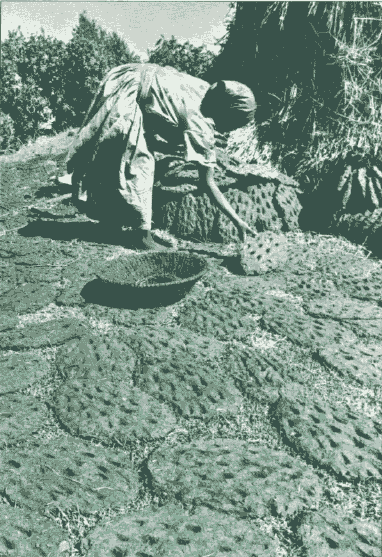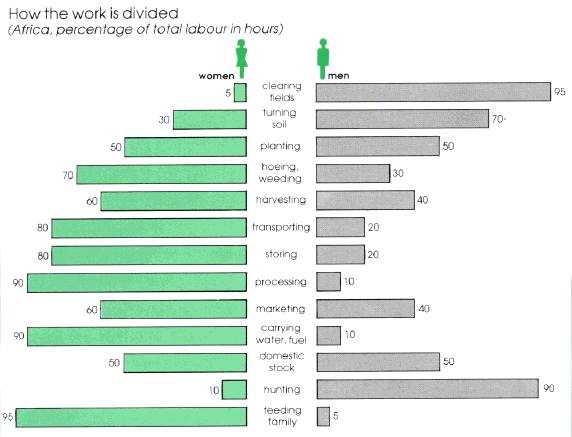


Events have conspired to deprive women of the relatively easy access they have had to tree products. The problem is not simply environmental: it also reflects the orientation of current development programmes towards cash economies, and widespread failures to understand the real nature of household economies. At the same time, the introduction of new technologies can undermine many of the small-scale forest industries that provide women with at least some cash income.
four factors that deprive women of the forest resources they need:
1. resource depletion
2. changing family structures
3. the introduction of new technologies
4. development projects that fail to target women

The ways in which women traditionally use forest resources are becoming increasingly unviable. There are four main reasons for this, each of which has a cumulative, negative impact on the lifestyle of rural women.
These four factors need to be considered by planners if they are to help restore the balance between women's needs and the forest and tree resources available to them Each includes issues related to both poverty and gender.

the last leaf- a Nepalese woman collects fodder from an almost bare tree
Conventional statistics on the rate of deforestation, or the speed at which desertification is proceeding, mean little to most rural women. The reality of their daily life is the long walk required to fetch fuel and water. As scrubland becomes depleted and the environment deteriorates, and as increasing numbers of people compete for diminishing resources, women find it more and more difficult to collect enough fuelwood in the time available to them.
They are then faced with several alternatives. The first is to use inferior wood for cooking. Softwoods may be substituted for hardwoods, and smaller and less convenient sizes for those normally used. This makes cooking more difficult and more time-consuming. It may also bring about changes in cooking methods, and subsequent changes in the nutritional values of the foods eaten.
The second, and increasingly common, solution is to cook less often. Where once the family could expect two or even three hot meals a day, this is first reduced to one a day and then- as in some parts of west Africa and many areas of the Andes- to once every other day. By this time, family levels of nutrition have usually fallen substantially because many of the staple foods consumed in rural households cannot be easily digested without prolonged cooking. Traditional diets have to be changed, and more and more raw foods introduced into the menu. In the peanut basin of Senegal, women are having to serve water mixed with raw millet flour in place of the cooked grain. In Guatemala, many families can no longer find enough fuel for the lengthy cooking required for their traditional staple of beans.
In the short term, raw food and unboiled water lead frequently to higher levels of disease. In the long term, cooking methods or food substitutions become adapted to the fuels available. Some examples of these adaptive strategies include the fermenting of beans before cooking to save on cooking time, and substituting less nutritious but quickly cooked foods for more nutritious ones that take longer to cook. The effects of these substitutions on nutrition are only beginning to be examined.
Factors such as length of cooking time have often been ignored in otherwise sound development plans- such as one in Burkino Faso which introduced soy beans into the diet. Many women refused to accept them, however, because they took longer to cook than the traditional cow peas. Throughout the Sahel, rice is increasingly favoured over millet because it is easier to prepare and quicker to cook. But the substitution of imported foods for traditional local crops has played havoc with many African economies and with household food security.
A third solution is to supplement fuelwood supplies with agricultural residues such as cassava stalks and dung. Where fuelwood is in very short supply, these materials become the main fuels of the household. Cooking with them is usually more difficult than with wood, and always requires a far greater bulk of material to be collected, moved and then burnt. Some 800 million people now rely on residues for at least some of their energy needs, and the implications for soil fertility and erosion are serious.
Agricultural wastes are an important form of fertilizer, providing the soil with both humus and inorganic nutrients. If they are burnt in the household, the soil is normally deprived of their fertilizing effect, and becomes impoverished. Lack of humus leads to instability, and wind and water erosion are increased. Lack of fertility means that farmers must. cultivate even larger areas of land to provide the quantities of produce their families require.
|
|
Severe fuelwood shortages often force women to purchase some of their fuel, usually from trade suppliers. By this time women have in effect lost control of their fuel supply because they have no access to the carts, animals and lorries necessary to turn fuelwood collection from a subsistence activity into a business. Furthermore, they have an added living expense - one that has provoked the West African saying that "it costs as much to cook the rice as it does to fill the bowl".
Resource depletion affects more than fuelwood collection. In the Niger, a whole new market has opened up for the purchase of items that women used to collect for nothing in the nearby forest. In Nepal, where women traditionally gather fodder for their livestock, shortage of trees has made the job almost impossible. When domestic animals have to be given up for lack of fodder, as they have in parts of both Burkina Faso and Mali, another item of food disappears from the subsistence economy, and another source of income disappears from the range of possibilities available to rural women.

making dung cakes for fuel in India; some 800 million people rely heavily on agricultural residues for their energy needs
Because the impact of forest depletion is felt so severely by women, they are usually anxious to participate in any decisions that are made about what new tree species are to be planted, and where. Women can thus provide an important input to planning.

where women are heads of the household- as here in the Andes-they must take on the men's jobs as well as their own
One reason why rural women work harder than ever before is that they have increased responsibilities. More and more women are now either legally, or in practice, the heads of their households. There are many reasons for this.
Sometimes it is a question of choice, since marriage can confine women to the subsistence economy and provides men with almost total control of cash income. Sometimes it is the result of desertion, divorce or abandonment. But the most common reason is migration. Men are away from home more frequently and for longer periods than they used to be. They go to seek work in the cities, in the mines, on the plantations, and in other countries where the rewards may be, or may appear to be, greater. As a result, at least one-third of all households are now formally headed by women. In one study of 73 countries, the country with the smallest proportion of female-headed households was Kuwait, with 10 percent. The highest was Panama, with 40 percent. A different study in Kenya, however, showed that 60 percent of rural households were either headed or managed by women. Overall, the proportion of households where a woman is in practice, if not in law, a household head is far higher than even one-third. In all these households, women have to take on jobs that were formerly performed by men. But other changes are occurring as well.
Traditionally, work roles are similar in many societies. Men clear land, turn the soil, hunt and fish, and do some of the planting. Women do the rest- and the rest involves much more than looking after the family. In most societies, women also plant, weed, harvest, carry the crops, fuelwood and fodder home, store them and market the excess. But this division of labour is changing. As cash economies replace subsistence ones, men have less and less to do with food production. Worldwide, women now produce more than 50 percent of all the food that is grown; in Africa, they produce about 80 percent. In some areas, large portions of this food come from trees.
A recent survey in Swaziland found that 59 percent of the ploughing was now being done by women. In some places, the woman's workload has increased so much that she cannot cope without more help from her daughters. The two obvious responses are to increase family size so that more labour becomes available, or to take daughters away from school.

traditionally, men clear the land, turn the soil, hunt and fish- and women do the rest. But even that is now changing
One of the major problems with the changing division of labour is that women gain new responsibilities but not the rights that should go with them. Many men now spend so long-earning money away from the farm that they are sometimes absent for years on end. Legally, however, they are still the heads of household. The wife has neither title to the land, nor ownership of the cattle she tends. She can use neither as collateral for loans to buy the seed or fertilizer she needs.
Frequently, she cannot change land use nor adopt new agroforestry practices without permission from her absent husband. There is therefore a need for institutional support for women in their new roles as household heads and managers.
Rural women are one of the last groups in society to benefit from modernization and the introduction of new technology. These are usually targetted at a cash economy rather than the household economy. New agricultural technologies often make life even harder for women. When a male head of household is given credit to buy a cultivator, or a share in a tractor, he soon begins to cultivate more land. His wife and daughters must then weed a larger area in the same time. When new, fast-growing "improved" tree species are introduced, they usually provide a cash crop, often at the expense of the multipurpose species that are used by women for food and fodder production, and to provide a source of income.
Modernization can also be a mixed blessing for women in the forest itself. In timber-rich Borneo, men and women have traditionally worked at wood-cutting as family teams. When heavy chain saws were introduced to improve productivity, women were effectively excluded from an activity that had valuable social functions as well as fiscal ones.
There is a need to consider the effects that the introduction of a technology may have on poverty itself, and on the respective roles and incomes of both men and women. New technologies, focused specifically on women's needs, are urgently needed. For example, shea butter is the major cooking oil used in many semiarid areas of Africa. It is processed from the nut of the tree Butyrospermum parkii by women who sell the surplus. The process, however, requires heating and prolonged whipping. Women have often requested labour- and energy-saving technologies for the job but these have yet to be developed.
In many rural areas, men are the winners in development projects and women the losers. Development experts who plan schemes to improve the lifestyles or increase the incomes of village communities have in the past rarely analysed the gender issues involved. Yet such issues are fundamental to integrated rural development.
When land resources are scarce, plans to maximize production in one area may reduce production in others. Because the things that women produce- and particularly those that they produce from forest resources- are rarely counted in official statistics, they get ignored. Cash crops are often the foci of forestry development. When more land is devoted to timber or pulp, it has to come from somewhere. Usually, it comes from areas of so-called 'useless' scrub. Far from being useless, it is these areas on which rural women depend for supplies of additional food such as fruit and nuts, for medicines, for fodder, and for raw materials for the household.
The ways in which women are affected by unintended side-effects of development projects are often subtle. In the Niger, for example, a highly 'successful' wind break project succeeded in raising crops between the rows of newly planted trees. But women's incomes actually fell as a result of the project-Only later was it realized that women used to keep small ruminants in the areas involved and had given up doing so after they had been fined for allowing their animals to stray into the newly planted areas.
Woodlot projects can also be a mixed blessing for rural women. Their need is for multi-purpose trees close to the homestead. Development experts often plan woodlots on the basis of a single species with either good fuelwood or timber characteristics. Men grow and guard the trees, and often sell some of the produce for their own benefit, in effect displacing the women who previously gathered and possibly sold many different forest products from the same area.
New technologies, and the development projects that lie behind them, often improve conditions for the men but leave women with as much- or even more- to do than before.
While the crisis of women and forest resources worsens, some encouragement can be taken from the fact that more is now beginning to be done about it, as the remainder of this publication makes clear. Two major themes are apparent. In the first, women themselves, either individually or with help from other women and men, have taken up the fight to protect their rights and their resources. Planners, too, have become more aware of the importance of gender issues in project development and, conversely, of the contribution that women, with their special knowledge of forest resources, can make.